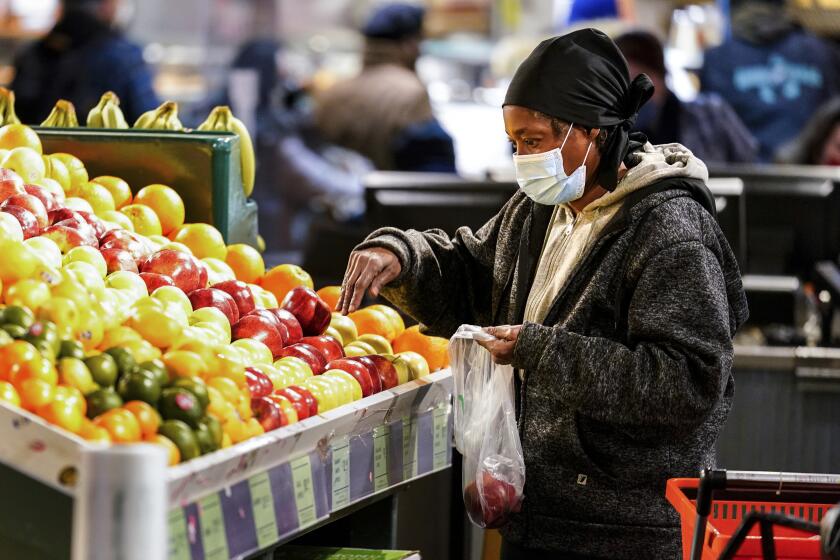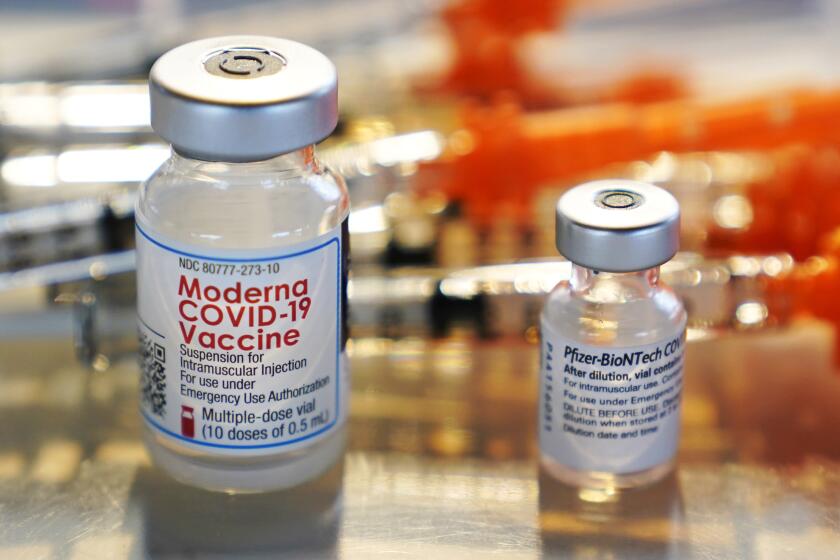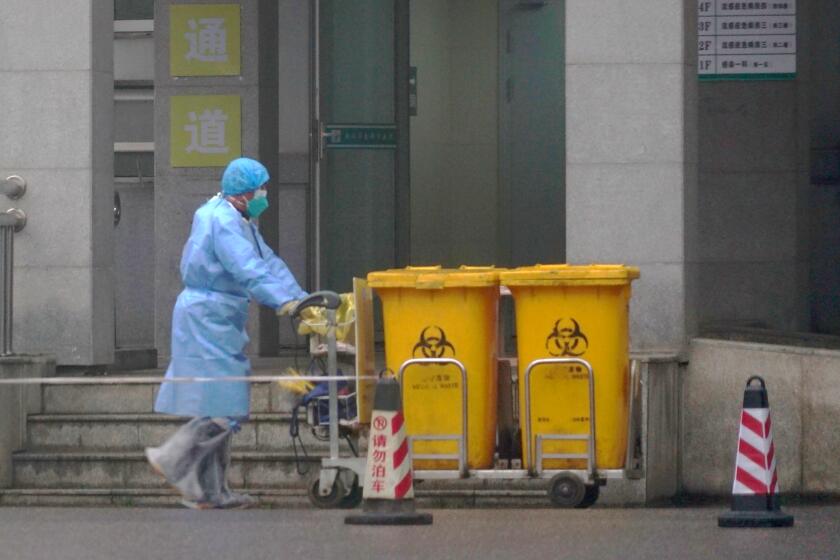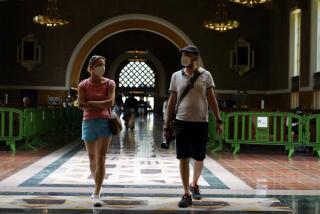A new L.A. mask mandate would have less value at this stage of the pandemic, some experts say
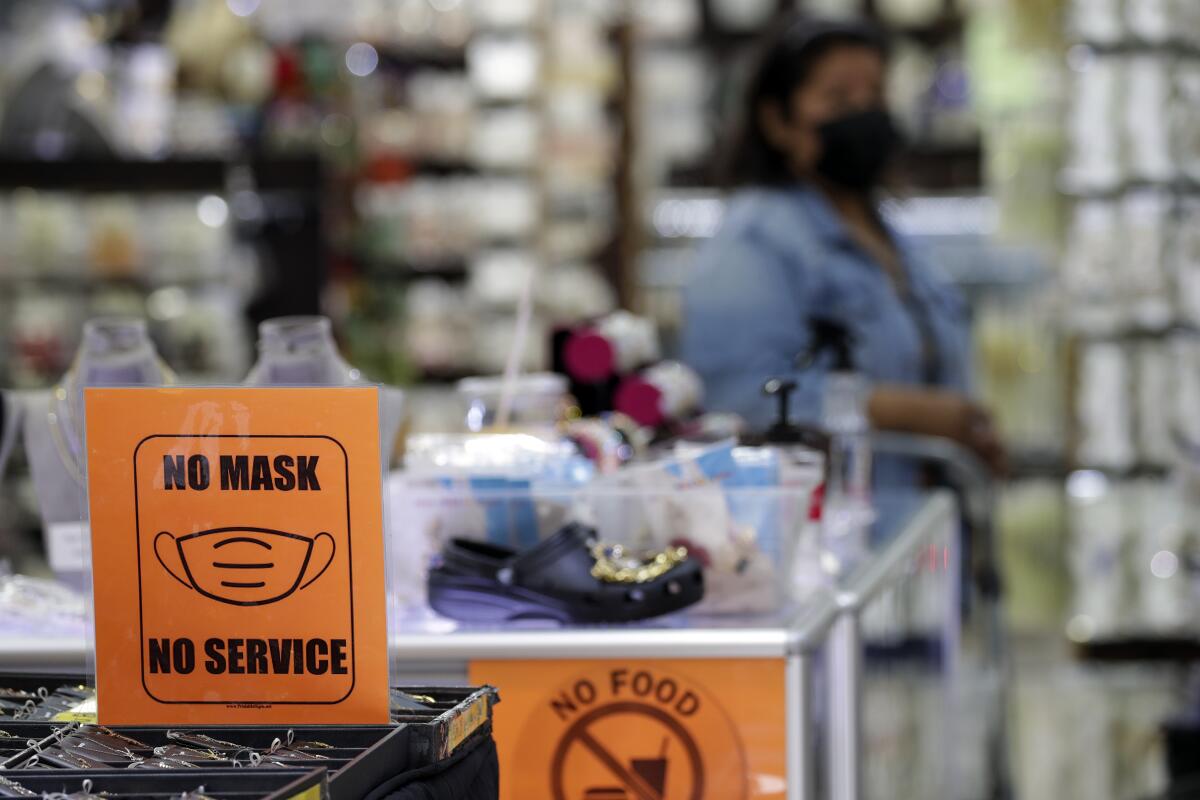
- Share via
As successive waves of COVID-19 have swept across the Southland, Michael Matteo Rossi, a 35 year-old filmmaker who lives in Los Feliz, has gamely masked up whenever he shopped, ate out or visited with his parents, who are in their 70s.
“I’ve never been like someone who walks into a Walmart without a mask, looking to make a big stink,” said Rossi, who is vaccinated. “I’m all about respect.”
But now, with Los Angeles County potentially on the verge of a renewed indoor masking mandate, his feelings have changed. With hospitalizations and deaths far below the peaks of the winter Omicron surge, Rossi said he feels safe mingling, maskless, in indoor spaces with his parents and friends.
His surgical mask, once an ever-present accessory, is abandoned somewhere in his car. He hopes it’s not coming back.
It may not need to. Support for renewed mask mandates has softened among medical and public health professionals as well. Despite L.A. County Public Health Director Barbara Ferrer’s plans to reinstate a mask mandate as soon as Friday if coronavirus conditions didn’t improve, others say the value of widespread masking isn’t what it used to be.
Thanks to a combination of widespread immunity, effective COVID-19 treatments and a more benign virus, there’s less reason to suppress viral spread by any means necessary, said Dr. Monica Gandhi, an infectious disease doctor who conducts public health research at UC San Francisco.
“We’re in a very different place in the pandemic,” Gandhi said. “At this point, I do not think that widespread masking is necessary.”
Pasadena, Long Beach and Beverly Hills have come out against a mask mandate in the wake of a spike of COVID cases fueled by Omicron subvariants.
Nothing captures Americans’ complex responses to the pandemic quite like the strip of material we’ve worn, on and off for 2½ years, to cover our noses and mouths.
Ever changing in its design and effectiveness, the face mask was first a tool to “flatten the curve” of infections until vaccines arrived. It became a condition for reopening schools, and has been touted as a measure to protect the elderly and vulnerable. It’s been a wordless signal of community resolve, and a noisy touchstone of struggle against government strictures.
On the faces of children, grocery shoppers, politicians and medical professionals, masks have done more than block the spread of airborne virus. They have muddled our words, eclipsed our facial expressions, steamed up our glasses and left us with sweaty chins.
In this, the third summer of the pandemic, it looked like we could dump our masks for good.
U.S. officials say most Americans live in places where healthy people no longer must wear masks. But they’re still required on public transit.
Then the Omicron subvariant known as BA.5 came along, sending infections in California to their third-highest peak of the pandemic.
Over the past week, Los Angeles County has averaged about 6,000 official coronavirus infections per day. (The number of additional cases identified using at-home is anyone’s guess.) That works out to 417 new infections per 100,000 residents per week. With that metric, anything over 100 is considered high.
But the thing that put a mask mandate back on the table was a steady increase in the number of newly hospitalized patients who tested positive for coronavirus infections.
Two weeks ago, that number rose to 10.5 per 100,000 residents, high enough to designate L.A. County as having a “high” COVID-19 community level based on criteria laid out by the Centers for Disease Control and Prevention. A week later, the number had climbed further, to 11.4 per 100,000.
Should it remain above 10 when new weekly figures are released today, Ferrer’s stated plan is to implement an indoor mask mandate that would apply to everyone 2 and older in restaurants, gyms, schools, shared office spaces, retail establishments and an array of other public venues.
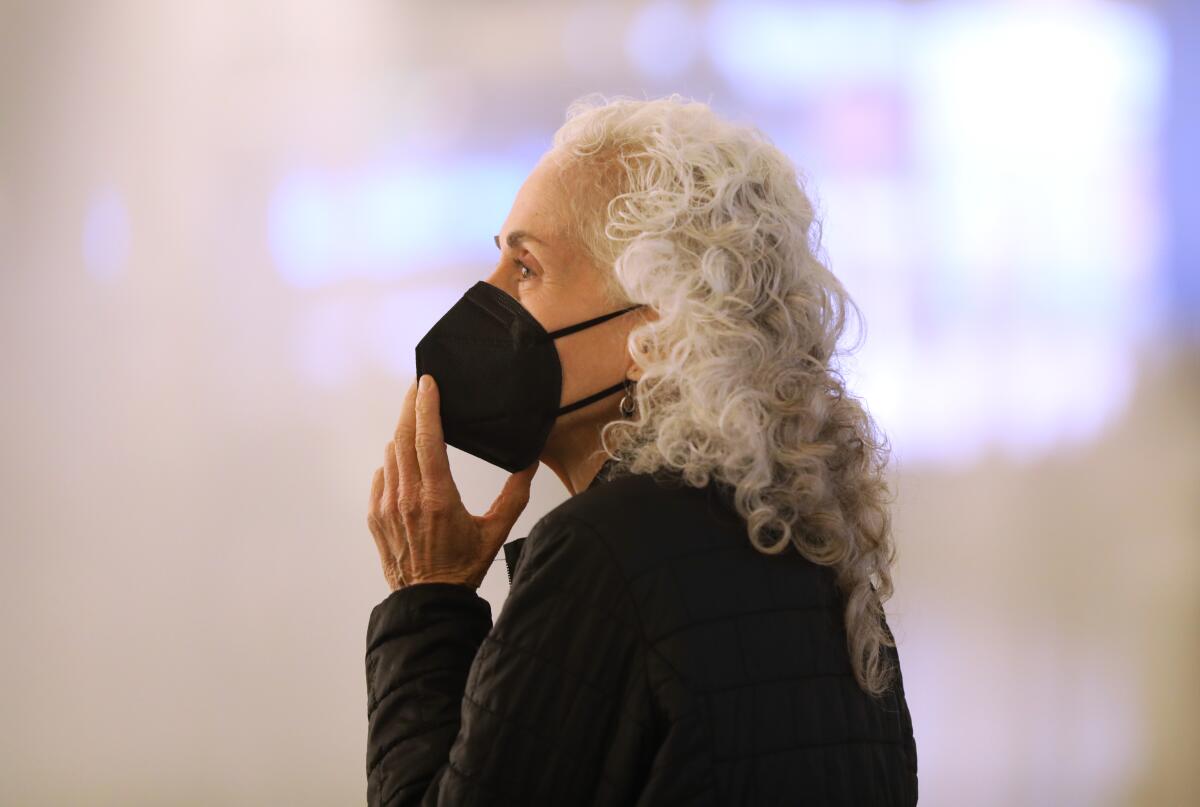
In recent days, Ferrer has raised the possibility of holding off on the mandate if “we see sustained decreases in cases, or the rate of hospital admissions moves closer to the threshold for medium” COVID-19 community levels.
Hospitalized patients with coronavirus infections are less of a burden in the BA.5 era, even if their numbers remain high. At Los Angeles County-USC Medical Center, the largest of four county-run public hospitals, around 90% of infected patients were admitted for something other than COVID-19 — and “virtually none of them to go the ICU,” according to Dr. Brad Spellberg, the hospital’s chief medical officer.
“It is just not the same pandemic as it was,” Spellberg said this month at a virtual town hall for hospital staffers. “A lot of people have bad colds, is what we’re seeing.”
Gandhi said that even steep increases in new infections have ceased to be a reliable predictor of hospital admissions for severe cases of COVID-19.
“We’ve started seeing a ‘decoupling’ of cases and hospitalizations,” she said.
With new COVID-19 boosters expected later this year, health experts urge Californians not to put off a first or second booster shot until then.
That’s largely due to COVID-19 vaccines. Their ability to prevent infections has waned as new variants became less recognizable to the immune system, but they still confer solid protection against hospitalization and death. For the roughly 71% of Americans ages 5 and up who have had at least two shots, vaccination reduced their risk of death sixfold, according to the CDC.
An ever-growing majority of Americans has some immunity conferred by a past infection as well. In February, the CDC estimated that nearly 60% of Americans had been infected by that point, months before BA.5 was detected here in May.
On top of that, the use of the antiviral Paxlovid in the first five days following a positive test can reduce the chance of hospitalization or death by as much as 88%. For people with weakened immune systems — an estimated 3% of Americans — prophylactic use of a monoclonal antibody called Evusheld reduced the risk of COVID-19 by 83% over six months; when taken after the onset of an infection, it drove down the risk of severe disease by 88%.
Plus, the Omicron variant now dominating the U.S. is less dangerous than the coronavirus strains that preceded it. The CDC has observed that the Omicron variant “generally causes less severe disease than infection with prior variants.” A recent study in the medical journal Lancet even suggests that the risk of developing long COVID after an infection with Omicron is less than half what it was with Delta.
“The threat has decreased,” said Dr. Jeffrey Duchin, chief health officer of Seattle and King County. “And for that reason, taking steps that are seen as inconvenient or costly or philosophically objectionable is less palatable and less desirable.”
Two new studies build on evidence that the coronavirus that causes COVID-19 jumped to humans in a Wuhan market, and did so twice.
In some cases, health officials are still turning to mask mandates out of instinct, Gandhi said.
When new infections rise, “that feels scary to a public health officer, and it feels like something they can do,” she said.
But if mask mandates no longer hold the promise of driving down hospitalizations and reducing deaths, they will be hard to defend — especially to an increasingly restive public.
“At this point we really do have to think about public health trust,” which has been deeply eroded during the pandemic, Gandhi said. “That is a real concern.”
When Rossi heard that a mask mandate was back on the table for L.A. County, he did not accept health officials’ words at face value. Instead, he complained to the L.A. County Board of Supervisors.
“I am asking as somebody who is from L.A. [and] done everything to keep safe, do NOT go back” to requiring masks, he told them.

Rossi insists his newfound mask skepticism is shared by friends across the ideological spectrum. He describes himself as an “apolitical person” who respects science and rejects conspiracy theories.
But at this point in the pandemic, he feels confident he is protected from severe COVID by his age, his hybrid immunity from the vaccine and a past infection, and Omicron’s milder nature. He takes comfort that his parents are vaccinated and boosted, and therefore at least six times less likely to become severely ill or die compared to people who are unvaccinated.
“This is not summer 2020. It’s not the winter of 2021,” Rossi said. “This is the summer of 2022. This time around, it’s different.”

